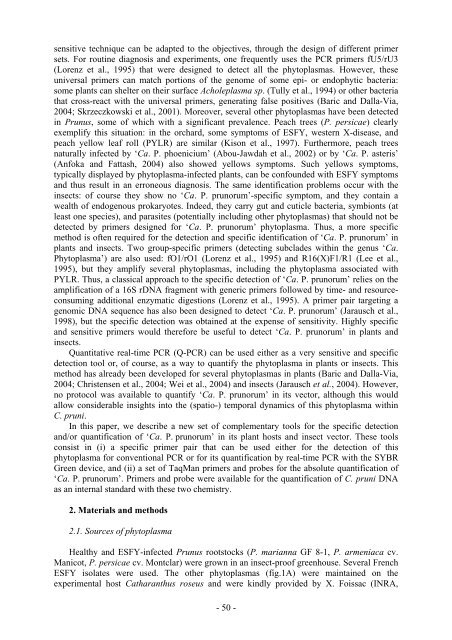Ecole Nationale Supérieure Agronomique de Montpellier ... - CIAM
Ecole Nationale Supérieure Agronomique de Montpellier ... - CIAM
Ecole Nationale Supérieure Agronomique de Montpellier ... - CIAM
Create successful ePaper yourself
Turn your PDF publications into a flip-book with our unique Google optimized e-Paper software.
sensitive technique can be adapted to the objectives, through the <strong>de</strong>sign of different primer<br />
sets. For routine diagnosis and experiments, one frequently uses the PCR primers fU5/rU3<br />
(Lorenz et al., 1995) that were <strong>de</strong>signed to <strong>de</strong>tect all the phytoplasmas. However, these<br />
universal primers can match portions of the genome of some epi- or endophytic bacteria:<br />
some plants can shelter on their surface Acholeplasma sp. (Tully et al., 1994) or other bacteria<br />
that cross-react with the universal primers, generating false positives (Baric and Dalla-Via,<br />
2004; Skrzeczkowski et al., 2001). Moreover, several other phytoplasmas have been <strong>de</strong>tected<br />
in Prunus, some of which with a significant prevalence. Peach trees (P. persicae) clearly<br />
exemplify this situation: in the orchard, some symptoms of ESFY, western X-disease, and<br />
peach yellow leaf roll (PYLR) are similar (Kison et al., 1997). Furthermore, peach trees<br />
naturally infected by ‘Ca. P. phoenicium’ (Abou-Jawdah et al., 2002) or by ‘Ca. P. asteris’<br />
(Anfoka and Fattash, 2004) also showed yellows symptoms. Such yellows symptoms,<br />
typically displayed by phytoplasma-infected plants, can be confoun<strong>de</strong>d with ESFY symptoms<br />
and thus result in an erroneous diagnosis. The same i<strong>de</strong>ntification problems occur with the<br />
insects: of course they show no ‘Ca. P. prunorum’-specific symptom, and they contain a<br />
wealth of endogenous prokaryotes. In<strong>de</strong>ed, they carry gut and cuticle bacteria, symbionts (at<br />
least one species), and parasites (potentially including other phytoplasmas) that should not be<br />
<strong>de</strong>tected by primers <strong>de</strong>signed for ‘Ca. P. prunorum’ phytoplasma. Thus, a more specific<br />
method is often required for the <strong>de</strong>tection and specific i<strong>de</strong>ntification of ‘Ca. P. prunorum’ in<br />
plants and insects. Two group-specific primers (<strong>de</strong>tecting subcla<strong>de</strong>s within the genus ‘Ca.<br />
Phytoplasma’) are also used: fO1/rO1 (Lorenz et al., 1995) and R16(X)F1/R1 (Lee et al.,<br />
1995), but they amplify several phytoplasmas, including the phytoplasma associated with<br />
PYLR. Thus, a classical approach to the specific <strong>de</strong>tection of ‘Ca. P. prunorum’ relies on the<br />
amplification of a 16S rDNA fragment with generic primers followed by time- and resourceconsuming<br />
additional enzymatic digestions (Lorenz et al., 1995). A primer pair targeting a<br />
genomic DNA sequence has also been <strong>de</strong>signed to <strong>de</strong>tect ‘Ca. P. prunorum’ (Jarausch et al.,<br />
1998), but the specific <strong>de</strong>tection was obtained at the expense of sensitivity. Highly specific<br />
and sensitive primers would therefore be useful to <strong>de</strong>tect ‘Ca. P. prunorum’ in plants and<br />
insects.<br />
Quantitative real-time PCR (Q-PCR) can be used either as a very sensitive and specific<br />
<strong>de</strong>tection tool or, of course, as a way to quantify the phytoplasma in plants or insects. This<br />
method has already been <strong>de</strong>veloped for several phytoplasmas in plants (Baric and Dalla-Via,<br />
2004; Christensen et al., 2004; Wei et al., 2004) and insects (Jarausch et al., 2004). However,<br />
no protocol was available to quantify ‘Ca. P. prunorum’ in its vector, although this would<br />
allow consi<strong>de</strong>rable insights into the (spatio-) temporal dynamics of this phytoplasma within<br />
C. pruni.<br />
In this paper, we <strong>de</strong>scribe a new set of complementary tools for the specific <strong>de</strong>tection<br />
and/or quantification of ‘Ca. P. prunorum’ in its plant hosts and insect vector. These tools<br />
consist in (i) a specific primer pair that can be used either for the <strong>de</strong>tection of this<br />
phytoplasma for conventional PCR or for its quantification by real-time PCR with the SYBR<br />
Green <strong>de</strong>vice, and (ii) a set of TaqMan primers and probes for the absolute quantification of<br />
‘Ca. P. prunorum’. Primers and probe were available for the quantification of C. pruni DNA<br />
as an internal standard with these two chemistry.<br />
2. Materials and methods<br />
2.1. Sources of phytoplasma<br />
Healthy and ESFY-infected Prunus rootstocks (P. marianna GF 8-1, P. armeniaca cv.<br />
Manicot, P. persicae cv. Montclar) were grown in an insect-proof greenhouse. Several French<br />
ESFY isolates were used. The other phytoplasmas (fig.1A) were maintained on the<br />
experimental host Catharanthus roseus and were kindly provi<strong>de</strong>d by X. Foissac (INRA,<br />
- 50 -



